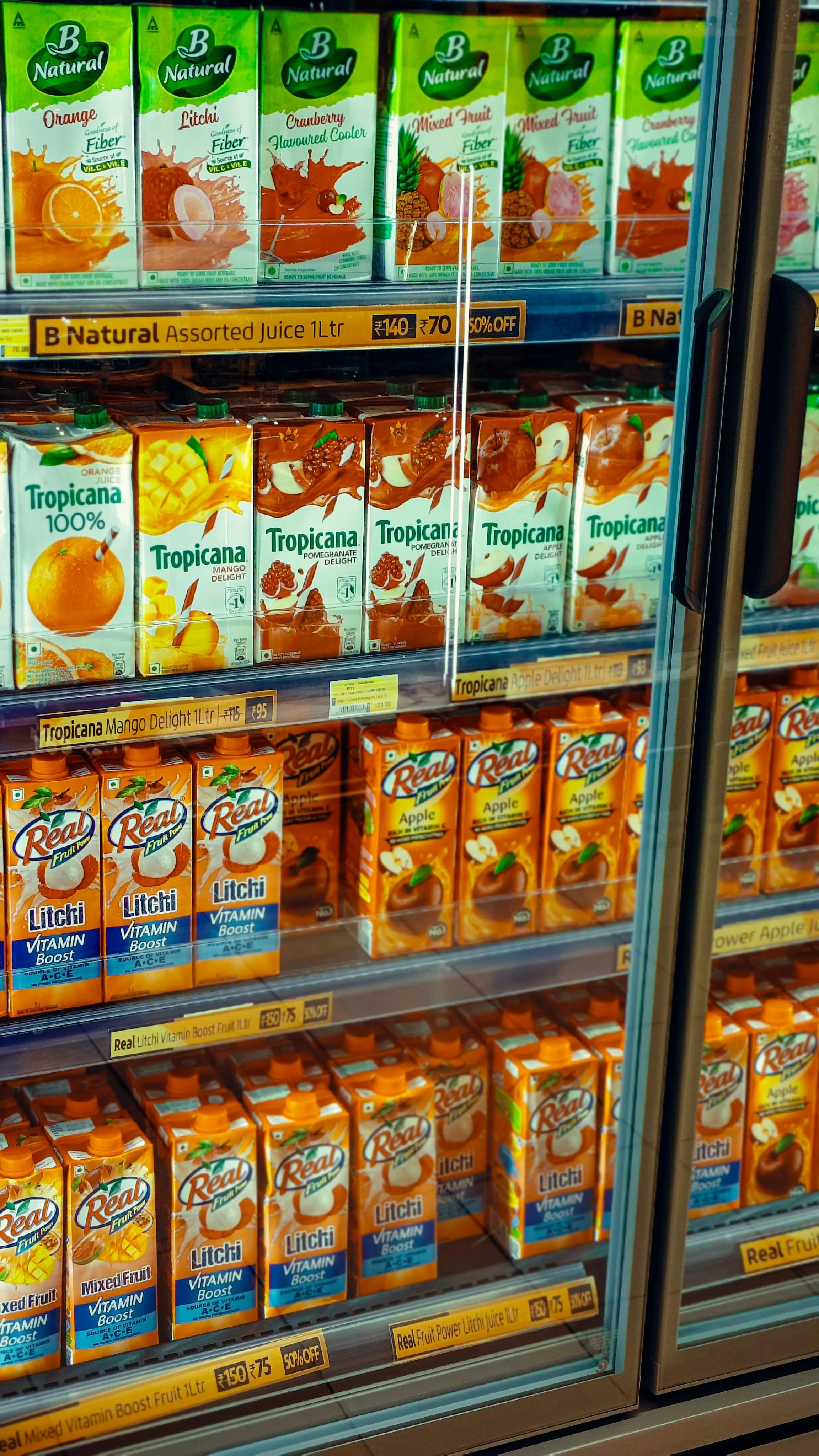5 Grocery Swaps: A Simple Guide to Make Healthy Easy
These days, walking through the grocery store can feel like navigating a maze of misleading labels. Nearly every product screams “healthy,” “low-fat,” or “all-natural,” but behind the flashy packaging and feel-good marketing lies a different truth: many of these foods are highly processed—and not nearly as nutritious as they claim to be.
In fact, processed foods—those loaded with added sugar, artificial sweeteners, high fructose corn syrup, and refined grains—have become so common that most of us have stopped questioning what’s really inside. These products are often stripped of important nutrients, packed with empty calories, and designed to make us crave more. And over time, they can wreak havoc on everything from our blood sugar levels to our heart health and even digestive health.
But the good news? You don’t need to overhaul your entire diet overnight. Making small changes—like swapping out white bread for whole grain bread, or choosing Greek yogurt over ice cream—is a simple way to take control of your health without sacrificing your favorite foods. By learning how to read the ingredient list—not just the nutrition label—you’ll be able to spot hidden additives, recognize fake health claims, and choose healthier alternatives that actually support your health goals.
This guide will walk you through 9 healthy food swaps that are practical, affordable, and empowering. We’ll focus on choosing more whole foods, cutting back on the processed stuff, and making confident decisions every time you shop.
Because when you know what you're really eating, you're not just following trends—you're building real, lasting healthy habits for better health.
Let’s get started with some simple swaps that make a big difference.
1. White Bread → Whole Grain or Homemade Sourdough
Bread is a staple in most households—but not all bread is created equal. One of the simplest food swaps you can make on your journey toward better health is replacing highly processed white bread with something more nutrient-dense. But before you grab that loaf of “whole wheat” bread and call it a day, let’s take a closer look.
What’s Wrong with White (and Wheat) Bread?
White bread is made from refined flour, which means the bran and germ—the parts of the grain that contain fiber, vitamins, and important nutrients—are removed. This leaves you with a product that spikes blood sugar levels, lacks grams of fiber, and contributes mostly empty calories to your diet.
But here’s the kicker: many wheat breads are no better. A lot of store-bought “whole wheat” breads still contain enriched flour, added sugar, preservatives, and even artificial sweeteners to improve flavor and shelf life. They’re marketed as healthy choices, but their ingredient list tells a different story.
Ingredients to watch for:
Enriched wheat flour (a processed grain)
High fructose corn syrup
Soybean or vegetable oil (high in omega-6, low in healthy fats)
Dough conditioners or “natural flavors” (ultra-processed additives)
Better Option: Whole Grain Bread (But Read the Label!)
If you’re not ready to bake at home, look for 100% whole grain bread where the first ingredient is “whole grain flour” or “whole wheat flour,” not “enriched” or “bleached” anything. Also check for minimal ingredients—simple is best. A great option will have:
3–5 grams of fiber per slice
Fewer than 3 grams of added sugar
Recognizable ingredients like whole grains, seeds, salt, and olive oil (a healthy fat)
Look for labels that say “sprouted whole grain” or “organic whole grain,” and avoid anything with a long ingredient list filled with preservatives or sweeteners.
Store-bought brand suggestion:
Ezekiel 4:9 Sprouted Grain Bread (found in the freezer section)
This bread contains whole foods like sprouted grains and legumes, no added sugar, and no preservatives. It’s as close to homemade as you’ll find in most grocery stores.
Best Option: Homemade Sourdough Bread
If you really want to upgrade your bread game, consider switching to homemade sourdough. Unlike conventional bread, sourdough is fermented using natural yeast and bacteria, which breaks down gluten, increases digestibility, and improves gut health. It’s made with just flour, water, and salt—no preservatives, oils, or fillers.
Why homemade sourdough is healthier:
Naturally fermented = better for digestive health
No need for added yeast, sugar, or oils
Long fermentation lowers blood sugar impact
Made from whole grains, depending on your flour choice
Easy to make with just a starter (you can learn how in [Sourdough Starter for Beginners — No Scale Needed] or [Easy Sourdough Bread Recipe])
Tip: Look for unbleached flour and try to use stone-ground whole wheat, rye, or spelt flour to maximize nutrition.
What About Bakery Bread?
Picking up a fresh loaf from the bakery can be tempting, but it still requires a closer look. Many bakery breads are made from the same refined flours and additives as packaged loaves—especially if they're not made in-house. Ask the bakery staff if the bread is made from scratch, what ingredients are used, and whether it's fermented (like sourdough) or made with commercial yeast and sweeteners.
If the bakery offers true sourdough or whole grain artisan bread with simple ingredients, that can be a great choice. But steer clear of soft, sweet sandwich-style loaves labeled “wheat” or “9 grain” without transparency on what’s inside.
2. White Rice → Brown Rice or Sweet Potatoes
White rice is another pantry staple that seems innocent enough—but it’s another one of those sneaky processed foods that offers very little in terms of important nutrients. While it’s affordable and easy to cook, swapping white rice for brown rice or sweet potatoes is a simple way to make a big impact on your health goals.
Why Skip White Rice?
White rice has had the bran and germ removed, which are the most nutrient-rich parts of the grain. What’s left is a fast-digesting starch that spikes blood sugar levels, provides virtually no fiber, and doesn’t keep you full for long. It’s often enriched with synthetic nutrients to replace what was stripped away during processing, but your body doesn’t absorb those as effectively as it would from whole foods.
Plus, because it’s such a common side dish, eating white rice regularly can crowd out vegetable intake and more nutrient-dense carbs that support heart health, digestive health, and weight loss.
Better Option: Brown Rice
Brown rice is a whole grain, which means it still contains the bran and germ. That makes it higher in fiber, plant-based proteins, and essential minerals like magnesium and selenium. It digests more slowly than white rice, which helps stabilize blood sugar levels and promotes better health long-term.
When choosing brown rice:
Look for “long grain brown rice” or “basmati brown rice”
Avoid flavored or pre-cooked rice packets—they often contain added salt, preservatives, and unhealthy fats
Cook in bone broth or with a splash of olive oil for extra flavor and nutrients
Best Option: Sweet Potatoes
Sweet potatoes are one of the most nutrient-dense carbohydrate options you can eat. They’re loaded with fiber, antioxidants, vitamin A, and potassium, and they naturally support digestive health, heart health, and even immune function. They’re sweet enough to feel comforting but don’t cause the same blood sugar crash as refined carbs like white rice or pasta.
Try them:
Baked, roasted, or mashed
In place of rice as a side
Diced into breakfast bowls or lettuce wraps
In sweet or savory dishes (they pair great with lean protein like salmon or turkey)
They’re naturally gluten-free, anti-inflammatory, and versatile enough to use in place of both white rice and white pasta.
If You’re Buying Store-Bought Rice…
Stick to plain brown rice or wild rice—not the instant or pre-seasoned varieties. Brands like Lundberg Farms offer low sodium, organic options with minimal ingredients and no added sugar or flavor enhancers. You can usually find these in the natural foods or rice aisle.
3. Ice Cream → Greek Yogurt or Dark Chocolate
Craving something cold, creamy, and indulgent? Ice cream is a comfort food for many—but it’s also a sugary snack food that can quietly sabotage your health goals. Packed with added sugar, saturated fat, artificial sweeteners, and empty calories, regular ice cream offers little nutritional value and is easy to overeat.
But don’t worry—you don’t have to give up dessert. This is where healthy food swaps shine, especially when you learn how to enjoy Greek yogurt like ice cream.
Rethink Ice Cream: It’s Not Just the Taste, It’s the Habit
Let’s be honest—it’s not just the taste of ice cream we love, it’s the experience. The cold, the creaminess, the sweet satisfaction. But here’s the truth: Greek yogurt, especially when frozen, can give you that same feeling—without the sugar crash or regret.
The idea that “frozen Greek yogurt is gross” is a mental block, not a fact. Most people have only tried the overly processed store-bought versions loaded with gums, fake sweeteners, and weird textures. But real Greek yogurt, full-fat or 2%, can be rich, smooth, and seriously satisfying when you prepare it right.
Better Option: Frozen Greek Yogurt
Instead of grabbing a pint of traditional ice cream loaded with added sugar, try this instead:
DIY frozen Greek yogurt bowl:
Start with plain, full-fat Greek yogurt (look for no added sugar)
Stir in a splash of vanilla extract, a drizzle of honey or maple syrup, and a few dark chocolate chips
Freeze for 20–30 minutes to thicken—or enjoy it right away for a soft-serve texture
Top with fresh fruit, sunflower seeds, or a sprinkle of cinnamon for extra flavor and important nutrients
This combo not only satisfies your sweet tooth, but it also gives your body protein, probiotics, and healthy fats—supporting digestive health, blood sugar levels, and even heart health.
Craving Chocolate? Make a Smarter Choice
If your nightly sweet fix is more about chocolate than cream, try dark chocolate instead of milk chocolate or sugary desserts. Look for 70% cocoa or higher—it contains less added sugar, delivers more antioxidants, and still feels indulgent in small amounts.
Smart snacking ideas:
A square or two of dark chocolate with almond milk
Greek yogurt topped with cacao nibs and berries
Homemade “chocolate bark” made with dark chocolate, nuts, and seeds
Store-Bought Suggestion:
If you need a ready-made frozen option, look for Greek yogurt-based brands like Yasso or Siggi’s frozen bars. Choose flavors with lower total fat, minimal added sugar, and no artificial sweeteners. Always check the ingredient list for simple, recognizable components—not a chemistry lesson.
4. Sour Cream → Greek Yogurt or Avocado
Sour cream is a familiar favorite—it’s rich, tangy, and adds that creamy touch to everything from tacos to baked potatoes. But it’s also high in saturated fat, often low in important nutrients, and doesn’t offer much in return besides flavor and texture. Many store-bought versions also include stabilizers, preservatives, and hidden ingredients that don’t belong in real food.
Luckily, there are simple food swaps that deliver all the creaminess with a major upgrade in nutrition.
Whatever it is, the way you tell your story online can make all the difference.
🥄 Smarter Swap: Greek Yogurt
Yes, we’re talking about Greek yogurt again—but that’s because it’s one of the most versatile healthier alternatives you can keep in your fridge. Swapping sour cream for plain, full-fat Greek yogurt is nearly effortless:
Why it works:
Same creamy texture, same tangy flavor
Higher in protein, lower in total fat
Supports digestive health thanks to natural probiotics
Adds grams of fiber when paired with whole food toppings
You can use Greek yogurt in place of sour cream in almost any recipe:
On tacos or burrito bowls
In dips like spinach-artichoke or ranch-style blends
Mixed with herbs and lemon for a low-sodium dressing
It’s one of the easiest healthy food swaps that doesn’t feel like one.
Creamy and Nutrient-Rich: Avocado
Make it stand out
If you’re looking to skip dairy altogether or just want to change things up, avocado is another incredible replacement for sour cream. It’s loaded with heart-healthy fats, fiber, and important nutrients like potassium and folate.
Why it’s a good idea:
Contains omega-3 fats and healthy fats your body needs
Doesn’t spike blood sugar levels
Naturally supports weight loss and digestive health
Offers that same smooth texture with a mild, buttery taste
Try it:
Mashed into tacos or burritos instead of sour cream
Blended with lime juice and salt for a creamy topping
Mixed with Greek yogurt for a hybrid “avocado crema”
What to Avoid in Sour Cream
If you’re sticking with sour cream occasionally, take a closer look at the ingredient list. Watch for:
High fructose corn syrup (yes, it shows up in flavored dips!)
Artificial thickeners like guar gum or carrageenan
“Light” or “reduced-fat” versions that substitute fat with added sugar or artificial sweeteners
When in doubt, stick with organic, full-fat versions with just a few ingredients: cream, milk, and active cultures.
Store-Bought Suggestion:
If you’re shopping, look for:
Fage or Stonyfield plain Greek yogurt (no added sugar, simple ingredients)
Wholly Guacamole brand for pre-made avocado options with no added salt or fillers
Both are easy to find in most grocery stores, and offer the convenience of processed food—without the processed ingredients.
5. Fruit Juice → Fresh Fruit or Infused Water
Fruit juice is one of the most misleading “health” foods on grocery store shelves. The label may say “100% juice,” show a photo of fresh oranges, or even claim to support heart health or the immune system—but take a closer look at the ingredient list and you’ll likely find a different story.
The Truth About Fruit Juice
Even “natural” or “no sugar added” juices are often highly processed foods that are:
Stripped of fiber (which slows digestion and keeps blood sugar stable)
Concentrated with natural sugars that act just like added sugar
Low in important nutrients that whole fruits provide in full form
Linked to spikes in blood sugar levels, weight gain, and even risk of heart disease in excess
Some juices even contain hidden artificial sweeteners, high fructose corn syrup, or “flavor packs” designed to make them taste fresh after long periods of storage.
Bottom line? Drinking juice isn’t the same as eating fruit.
Better Choice: Whole, Fresh Fruit
Instead of fruit juice, choose the real thing—fresh fruit. You’ll get:
Grams of fiber to support digestive health and satiety
Natural vitamins and antioxidants your body can use
Fewer empty calories and more balanced energy
Pair fruits like oranges, apples, or berries with plant-based proteins like sunflower seeds or hard-boiled eggs for a balanced diet that satisfies without the sugar spike.
Simple Swap: Infused Water
If you're craving flavor without calories or sugar, try infused water. It’s a refreshing simple way to ditch sugary drinks without feeling bored.
Try combinations like:
Cucumber + lemon + mint
Strawberry + basil
Orange + cinnamon stick
Let it chill in your fridge and enjoy it throughout the day—it’s a smart, low sodium, no sugar alternative to soda and juice alike.
Store-Bought Suggestion:
Need a quick grab-and-go option? Look for:
Hint Water or Spindrift (flavored with real fruit, no added sugar or fake sweeteners)
No pulp, unsweetened cold-pressed juices—used in small amounts and diluted with water
Still, real whole foods win every time.
Final Thoughts: Small Changes, Real Confidence
Make it stand out
Choosing healthier food swaps isn't about restriction or chasing perfection—it's about education, awareness, and small changes that add up over time.
You don’t have to be an expert or spend hours reading every nutrition label. You just need to:
Prioritize whole foods over processed foods
Check the ingredient list, not just the nutrition facts
Watch for added sugar, artificial sweeteners, and long, unrecognizable ingredients
Make swaps that support your health goals without sacrificing flavor or joy
From switching white bread to homemade sourdough, swapping ice cream for Greek yogurt, or choosing fresh fruit over juice, you’re not just changing your plate—you’re reclaiming your confidence, your health, and your future.
Remember, your next trip to the grocery store doesn’t need to be overwhelming. You now have the tools, the simple swaps, and the mindset to shop smarter and nourish better—one label, one ingredient, and one bite at a time.
Keep Reading: Helpful Guides to Support Your Health Journey
You’ve taken the first step by learning how to make simple grocery swaps—but this is just the beginning of your health journey! Here are some reader-favorite blog posts and upcoming topics to look forward to:
What to Do With Sourdough Discard: 10 Top Recipes
Discover creative, easy, and delicious ways to use your discard instead of tossing it out.Beginner’s Guide: How to Make Easy Sourdough Bread
No scale? No problem. Learn how to bake fresh, homemade sourdough with just the basics.Cheyenne, Wyoming Spring Garden Tips for Beginners
Start your garden strong with lessons learned from real Wyoming soil, wind, and weather.Best Drought-Resistant Plants for Cheyenne, Wyoming
Create a low-maintenance, water-wise landscape that thrives in tough climates.Native Perennials for Low-Maintenance WY Gardens
Beautify your yard with hardy plants that support pollinators and require less effort.









